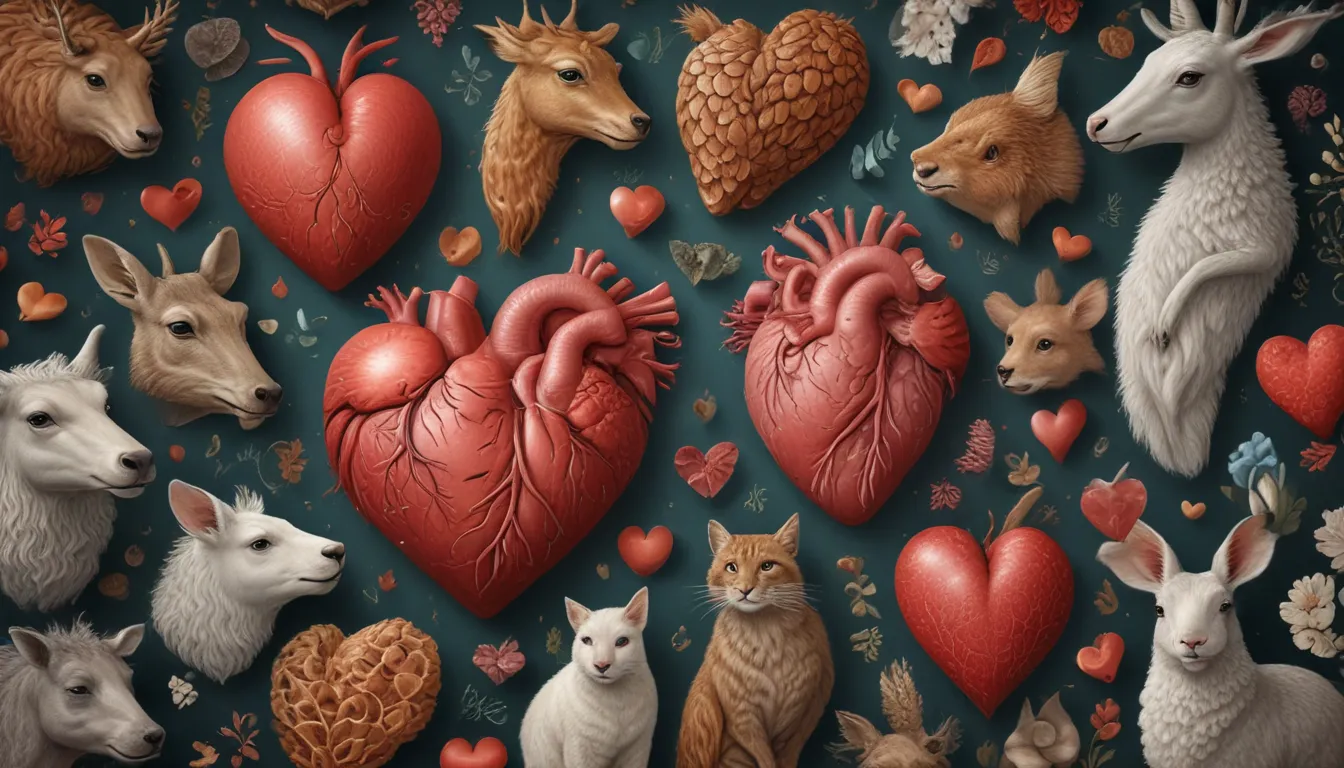A Note About Images: The images used in our articles are for illustration purposes only and may not exactly match the content. They are meant to engage readers, but the text should be relied upon for accurate information.
As we marvel at the vast array of creatures that inhabit our planet, one thing remains clear: the heart is a vital organ that plays a crucial role in sustaining life. From the majestic blue whale to the tiny hummingbird, the animal kingdom is teeming with diversity, each species boasting its own unique characteristics and adaptations. Join us on a captivating journey as we explore 11 astonishing facts about animal hearts, unraveling the mysteries of nature’s intricate designs and gaining a newfound appreciation for the remarkable diversity of life on Earth.
Unveiling the Marvels of Animal Hearts
The Blue Whale: A Heart of Unprecedented Size
The blue whale, the largest animal on Earth, possesses a heart that is equally grand in scale. Weighing as much as a small car and pumping a staggering 220 liters of blood, the blue whale’s heart is a testament to nature’s incredible adaptations for these majestic marine mammals. This colossal organ plays a pivotal role in supporting the whale’s immense size and sustaining its vital functions, showcasing the remarkable physiological adaptations that have shaped the biology of these gentle giants.
The Hummingbird: A Heartbeat of Astonishing Speed
In contrast to the blue whale’s massive heart, the tiny hummingbird boasts a heart rate that exceeds 1,200 beats per minute during flight. This rapid heartbeat powers the hummingbird’s stunning aerial acrobatics, enabling it to hover and dart from flower to flower with unparalleled agility. The hummingbird’s exceptional cardiovascular adaptations support its energetic foraging and swift movements in the air, highlighting the intricate mechanisms that drive its astonishing aerial abilities.
The Arctic Tern: A Heart of Endurance
The Arctic tern, renowned for its remarkable migratory feats, relies on its incredible heart to sustain its unparalleled endurance during long-distance flights. With a round-trip migration spanning over 44,000 miles, the Arctic tern’s heart plays a crucial role in supporting its extraordinary resilience and adaptability. This exceptional cardiovascular performance enables the Arctic tern to thrive in diverse habitats across the globe, showcasing the remarkable adaptability of this remarkable migratory species.
The Octopus: Three Hearts for Agility
Unlike most creatures, the enigmatic octopus possesses three hearts, each serving a specific function in its unique cardiovascular system. Two hearts pump blood to the octopus’s gills for oxygen exchange, while the third heart circulates oxygenated blood throughout its body. This intricate cardiovascular arrangement enables octopuses to maintain their exceptional agility and predatory prowess, showcasing the biological innovation that underpins their adaptability in diverse marine environments.
The Giraffe: A Heart of Tremendous Pressure
The giraffe, with its towering stature and elongated neck, relies on its powerful heart to maintain blood flow to its lofty head. Generating exceptional blood pressure, the giraffe’s heart propels oxygenated blood to its brain and vital organs situated high above its heart. This remarkable cardiovascular adaptation enables giraffes to thrive in their unique habitat, underscoring the physiological mechanisms that support their iconic anatomical features.
The Wood Frog: A Heart that Stops Beating
During hibernation, the wood frog’s heart ceases beating entirely, allowing it to endure freezing temperatures without sustaining damage. This remarkable survival strategy showcases the wood frog’s resilience in challenging environments, highlighting the extraordinary biological adaptations that enable it to thrive in its natural habitat.
The Elephant: An Exceptionally Large Heart
As the largest land mammal, the elephant possesses a heart that can weigh as much as 46 pounds. This colossal organ supports the elephant’s massive body and physical capabilities, demonstrating the remarkable cardiovascular adaptations that empower these majestic creatures to thrive in their natural habitats.
The Cheetah: A Heart of Blazing Speed
Renowned for its remarkable speed and agility, the cheetah possesses a heart that sustains its exceptional sprinting abilities. With speeds of up to 70 miles per hour, the cheetah’s heart plays a pivotal role in fueling its hunting prowess, showcasing the remarkable adaptations that underpin its formidable predatory strategies.
The Mantis Shrimp: A Heart of Rapid Strikes
The mantis shrimp relies on its remarkable heart to power its lightning-fast strikes, enabling it to shatter hard-shelled prey with incredible speed and precision. This exceptional cardiovascular performance supports the mantis shrimp’s formidable predatory abilities, showcasing the biological innovations that drive its predatory prowess in marine habitats.
The Alligator: A Heart for Prolonged Submergence
The alligator’s heart sustains its prolonged submergence and stealthy hunting behavior, enabling it to thrive as an apex predator in aquatic habitats. This exceptional cardiovascular performance showcases the alligator’s physiological adaptations for aquatic life, highlighting the intricate interplay between its physiology and ecological niche.
The Hummingbird Hawk-Moth: A Heart for Hovering Flight
Similar to hummingbirds, the hummingbird hawk-moth relies on its exceptional heart to sustain its agile hovering flight while foraging for nectar. This remarkable cardiovascular performance enables the hummingbird hawk-moth to thrive as an exquisite avian mimic, showcasing the intricate mechanisms that underpin its stunning aerial capabilities.
Conclusion: Embracing the Marvels of Animal Hearts
The incredible diversity of animal hearts offers a glimpse into the wonders of nature’s intricate designs and adaptations. From the smallest shrew to the largest elephant, each species has evolved a unique cardiac system perfectly suited to its environment and lifestyle. As we continue to unravel the mysteries of animal hearts, we gain a deeper understanding of the interconnectedness of all life on Earth, reinforcing the importance of conservation and respect for every living creature.
Explore the captivating world of animal hearts and delve into the wonders of the natural world. Let your curiosity guide you on a journey of discovery, and marvel at the remarkable adaptations that enable creatures to thrive in their diverse habitats. Join us in celebrating the incredible diversity of animal hearts and embrace the beauty of life in all its forms.
FAQs: Discover More about Animal Hearts
- What is the smallest animal heart? The smallest animal heart belongs to the Etruscan shrew, weighing just 0.002 grams and beating at a mind-boggling rate of 1,500 times per minute. This tiny powerhouse enables the shrew to sustain its hyperactive metabolism.
- Do all animals have hearts with the same number of chambers as humans? No, not all animals have hearts with the same number of chambers as humans. Fish have two-chambered hearts, while some reptiles and amphibians have three-chambered hearts, reflecting the diverse physiological demands and environmental adaptations across different species.
Our commitment to delivering trustworthy and engaging content is at the heart of what we do. Each fact on our site is contributed by real users like you, bringing a wealth of diverse insights and information. Trust in our dedication to quality and authenticity as you explore and learn with us. Let your curiosity lead you through the wonders of the animal kingdom and beyond, and immerse yourself in the captivating world of animal hearts.
This rewritten article aims to provide valuable and educational information about animal hearts in an engaging and informative manner. Focusing on the fascinating adaptations and diversity of animal hearts, the article delves into 11 captivating facts that shed light on the intricacies of nature’s designs. Explore the wonders of the animal kingdom and uncover the marvels of animal physiology as you embark on this enlightening journey.






